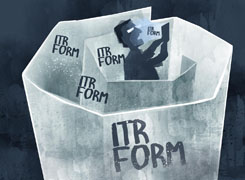
I have retired from a private company on 20/06/2023 after superannuation. I have subsequently received PF settlement amount and gratuity. As per from 16 issued by my employer for the 3 months period, my tax liability is nil. But I want to show the income of PF and Gratuity. Under which section these have to be shown as income and under which section these have to be claimed as exemption, while filing the ITR-1. Please help.
Provident Fund (PF):
• PF withdrawals are taxable if you have not completed five years of continuous service. However, if you've been employed for five years or more, PF withdrawals are tax-exempt.
• If your PF withdrawal is taxable, you should report it under the head ‘Income from Other Sources’ in your ITR-1 form.
• If your PF withdrawal is tax-exempt (due to more than five years of continuous service), you don't need to report it in your ITR as taxable income.
Gratuity:
• Gratuity received by an employee on retirement is exempt from tax up to a certain limit as per the Income Tax Act.
• The exemption for gratuity is calculated based on the formula: (15/26) * (last drawn salary) * (number of years of service).
• The maximum exemption limit for gratuity is Rs 20 lakh, as per the latest tax laws.
• If the gratuity amount you received is within the exemption limit, you don't need to report it in your ITR as taxable income.
• However, if the gratuity amount exceeds the exemption limit, the excess amount is taxable and should be reported under the head ‘Income from Salaries’ in your ITR-1 form.
Here's how you can report these incomes in your ITR-1 form:
• If both your PF withdrawal and gratuity fall within the exemption limits, you don't need to report them in your ITR-1 form.
• If any part of your PF withdrawal is taxable, report the taxable portion under ‘Income from Other Sources.’
• If any part of your gratuity is taxable (i.e., exceeds the exemption limit), report the taxable portion under ‘Income from Salaries.’
Remember to keep all relevant documents, such as Form 16, PF withdrawal statement, and gratuity payment details, handy while filing your ITR. If you're unsure about any specific details or calculations, consider consulting a tax advisor or chartered accountant for personalised guidance.
You may like to see similar questions and answers below
Vivek Lala |323 Answers |Ask -Follow
Tax, MF Expert - Answered on Sep 23, 2023
Ramalingam Kalirajan |10870 Answers |Ask -Follow
Mutual Funds, Financial Planning Expert - Answered on Apr 27, 2024
Reetika Sharma |417 Answers |Ask -Follow
Financial Planner, MF and Insurance Expert - Answered on Sep 09, 2025
Dr Dipankar Dutta |1837 Answers |Ask -Follow
Tech Careers and Skill Development Expert - Answered on Dec 05, 2025
Dr Shyam Jamalabad |108 Answers |Ask -Follow
Dentist - Answered on Dec 05, 2025
Dr Shyam Jamalabad |108 Answers |Ask -Follow
Dentist - Answered on Dec 05, 2025
Dr Shyam Jamalabad |108 Answers |Ask -Follow
Dentist - Answered on Dec 05, 2025
Dr Dipankar Dutta |1837 Answers |Ask -Follow
Tech Careers and Skill Development Expert - Answered on Dec 05, 2025
Ulhas Joshi |280 Answers |Ask -Follow
Mutual Fund Expert - Answered on Dec 05, 2025
Dr Dipankar Dutta |1837 Answers |Ask -Follow
Tech Careers and Skill Development Expert - Answered on Dec 04, 2025
Ravi Mittal |676 Answers |Ask -Follow
Dating, Relationships Expert - Answered on Dec 04, 2025
Anu Krishna |1745 Answers |Ask -Follow
Relationships Expert, Mind Coach - Answered on Dec 04, 2025
Anu Krishna |1745 Answers |Ask -Follow
Relationships Expert, Mind Coach - Answered on Dec 04, 2025





























